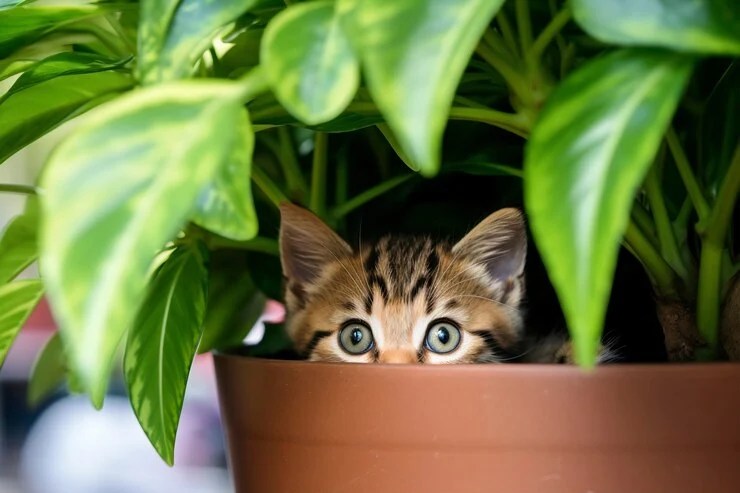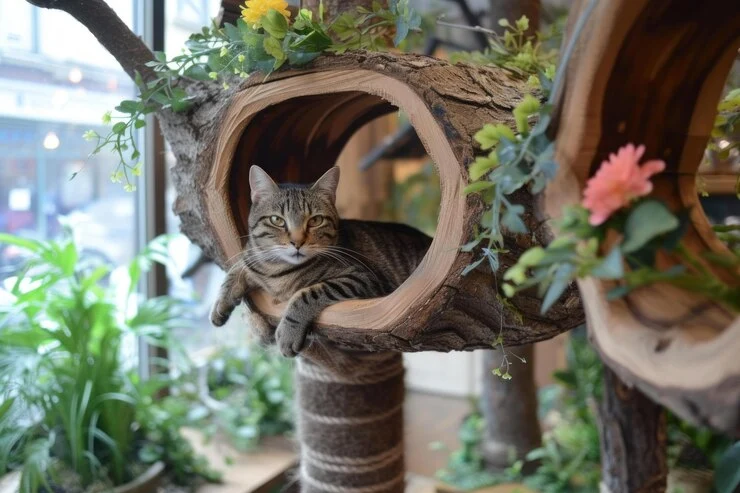Are you thinking about getting a cat tree for your feline friend? You’re in the right place! This guide will help you explore the options available, so you can choose the best cat tree to meet your pet’s needs while enhancing your home environment. Cats are naturally curious and love to climb, scratch, and perch. A well-designed cat tree caters to these instincts and provides a safe and engaging space for your cat to explore.
What is a Cat Tree?
A cat tree (also known as a cat tower or climbing structure) is a piece of furniture designed specifically for cats. These trees allow cats to engage in their natural behaviours such as climbing, scratching, and lounging. They are built with various levels, platforms, and posts, usually covered in materials that encourage scratching, like sisal rope. They may also have enclosed spaces that act as hideouts for your pet to relax in.
Why Do Cats Need a Cat Tree?
Cats are instinctively drawn to vertical spaces, and in the wild, they often climb trees to survey their territory or escape danger. A cat tree provides an indoor environment that satisfies these instincts. It gives your cat a sense of security by offering a high vantage point to observe their surroundings, reducing anxiety and stress. Moreover, the scratching posts can help save your furniture by redirecting your cat’s need to scratch.
The Health Benefits of a Cat Tree
While it is a fun and stimulating environment for your pet, it also promotes physical and mental health. Cats need exercise to maintain a healthy weight and avoid conditions like obesity. The various levels of a cat tree encourage your cat to jump and climb, offering a good form of exercise. Additionally, having a space where your cat feels safe and in control can reduce stress and anxiety, leading to better overall well-being.
Choosing the Right Size Cat Tree for Your Home
When selecting the perfect cat tree, one of the most critical factors to consider is size. You need to measure the space where you plan to place the cat tree. There are compact options available for small spaces, and larger, multi-level designs for homes with more space. If you live in a flat or smaller house, look for vertical designs that don’t take up much floor space but offer plenty of height for your cat to enjoy.
Materials Used in Cat Trees
The materials used in a cat tree will determine its durability and comfort for your cat. Most high-quality cat trees are made with a combination of wood, plush fabric, and sisal rope. Sisal rope is excellent for scratching posts because it’s tough and durable, yet safe for your cat’s claws. The fabric covering should be soft and comfortable, providing your cat with cosy spots to lounge.
- Wood: Provides stability and strength.
- Plush fabric: Adds comfort and makes the tree more inviting.
- Sisal rope: Encourages natural scratching behaviour and keeps claws healthy.
The Importance of Stability in Cat Trees
Stability is essential when choosing a cat tree. Cats love to jump and leap from one level to another, so a tree that wobbles or topples easily can be dangerous. Look for solid bases and well-anchored platforms. If your cat is particularly large or active, you might want to invest in a sturdier model with a broader base for extra support.
Types of Cat Trees

There are various types of cat trees, each catering to different cat behaviours and home environments. Here are some of the most common types:
- Multi-Level Cat Trees: These trees come with multiple levels, platforms, and sometimes even hammocks or swings. They’re perfect for active cats who love to climb and explore.
- Scratching Post Towers: These focus more on providing plenty of scratching surfaces. They may not have as many platforms but are ideal for cats who love to scratch.
- Compact Cat Trees: These trees are smaller and ideal for flats or homes with limited space.
- Luxury Cat Trees: These high-end options come with unique features like built-in toys, hideouts, and even faux plants to simulate a more natural environment.
Customising Your Cat Tree
Some cat trees allow for customisation, where you can add or remove components like extra platforms, ramps, or scratching posts. This can be especially helpful if you have multiple cats with different preferences. You can make the tree more engaging by incorporating hanging toys, additional soft cushions, or even heated pads during colder months.
Cost Considerations
The cost of a cat tree can vary significantly depending on the materials, size, and features. Budget-friendly cat trees can start as low as £30, while luxury models can go up to £300 or more. When choosing a cat tree, remember that you’re investing in your pet’s happiness and health, so durability and stability should be key considerations, even if it means spending a bit more.
Where to Place Your Cat Tree
The placement of the cat tree can significantly influence how much your pet uses it. Cats love to be where the action is, so try placing the tree near a window where your cat can watch birds or people. If your cat is more on the shy side, you might want to put it in a quieter room where they can retreat when they want some solitude.
Maintenance of Cat Trees
To keep your cat tree in top shape, regular maintenance is essential. Vacuum the plush areas to remove cat hair, and check the scratching posts for wear and tear. If the sisal rope begins to fray, you can often replace it, extending the life of the tree. Ensure that the platforms and posts remain stable and tighten any loose screws periodically.
Best Cat Tree Brands in 2024
There are several reputable brands known for producing high-quality cat trees in 2024. Here are a few to consider:
- Frisco: Known for durable, budget-friendly cat trees.
- Vesper: Offers sleek, modern designs that blend into home décor.
- Go Pet Club: Provides a wide variety of multi-level trees suitable for all cat sizes.
- Armarkat: Specialises in sturdy, large cat trees designed for multiple cats.
Conclusion
Investing is one of the best ways to provide your cat with mental stimulation, physical exercise, and a sense of security. With so many options available, you’re sure to find the perfect fit for your home and your cat’s needs. Consider factors like size, stability, materials, and cost when making your choice. Remember, a happy and healthy cat is a cat with space to climb, scratch, and relax—exactly what a cat tree provides.
A well-chosen cat tree is more than just a piece of furniture—it’s a small investment in your cat’s happiness, health, and well-being.
